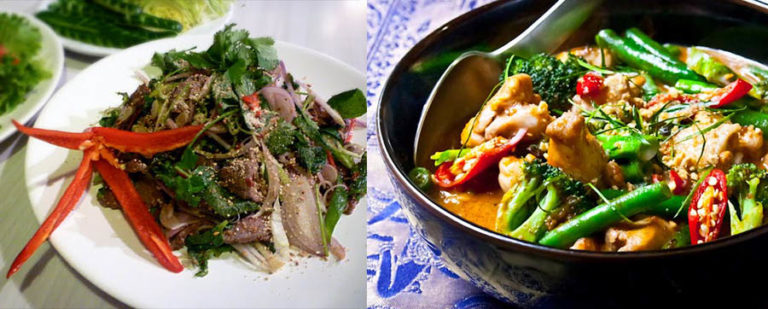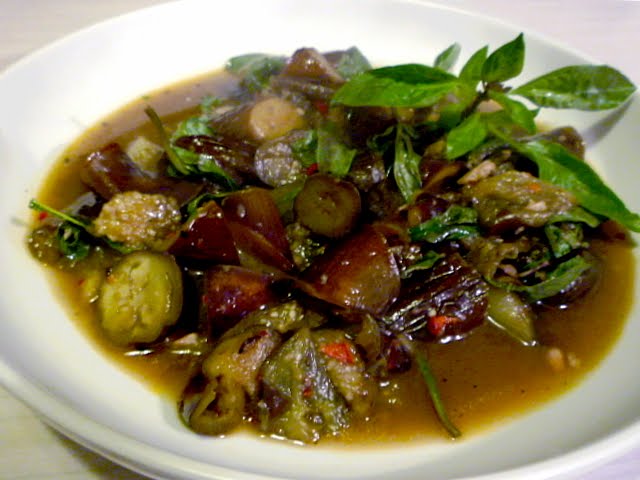
กินกิน! Kin Kin! Eat Eat! – Thai Cooking
Thai food is an intoxicating mix of salty, sweet, sour, crunchy, fresh, noodles, fragrant herbs, chillies, and more. It’s an amazing burst of flavour and textures, partners perfectly with a beer and is great to make big platters for sharing.
There are four distinct regions of Thai cooking central, northern, southern, and north eastern which is called Isan. Rather than focus on the differences today let’s just highlight some of the cupboard basics to get us started cooking up some delicious Thai food.
The Thai Pantry
Fish sauce – is the cornerstone ingredient that is found in almost all Thai dishes. It is made of anchovies and salt and is fermented to achieve a highly pungent and full flavour that is balanced wonderfully with sour ingredients and sugar.
Palm sugar – is a lighter colour sugar, usually sold in a solid block that then is grated or broken into pieces to melt into what you’re cooking. There are also darker palm sugars, they are usually used more in desserts and if it’s all you have access to then you can supplement half white sugar so that the flavour isn’t too strong.
Coconut milk is a staple in Thai cooking, it makes the red and green curries rich and delicious. Try to get a good brand of coconut milk without stabilisers. If you are careful not to shake the can then you can take the cream (solid white bit) out and add it to a hot wok and it should split into oil and cream – this is called ‘cracking the coconut’.
Tamarind concentrate, juice, pulp, or fresh gives that tart, sour, sweet taste to pad thai and is used in papaya salads and many more dishes.
Rice is the central dish that brings together all meals. It is generally white long grain rice just cooked in water. There are variations with coconut that are common in restaurants but at home it’s regular boiled or steamed rice. There is sticky rice which is made with glutinous (not wheat gluten) rice and coconut milk and is more common in the north of Thailand.
Toasted rice -khao khua is toasted rice powder that is used in north eastern Isan cuisine. It adds a nutty flavour and great texture to salads and larbs. In restaurants they put crushed peanuts in place of khao kua but I’m sure once you try it you’ll make the small effort to make it to add a dimension to the dish.
Rice noodles are common in Thai cooking and come in three sizes, from an angel hair to a thicker flat noodle. Usually they are bought dried and then rehydrated and cooked. They are often labelled ‘rice stick’ noodles. There are also fresh rice noodles for soups and more northern dishes.
Curry paste – green, yellow, red, masaman, panang. Thailand is famous for its curry and most people, even in Thailand, use the prepared curry pastes. Fresh curry pastes are always better, of course, but it can be hard to find some of the ingredients, coriander root is very hard to find in Barcelona and is essential to making curry pastes at home. If you find it, add it to Sawcer, we’ll all appreciate it!
My close friend in Australia, Suresh, has put together these gorgeous curry paste recipes.
Thai fresh produce
Chillies – Thai food is SPICY! That’s part of the reason I love it. There are many types of dried chili that are used in cooking.
Limes – are used to add the acidic taste and complexity to Thai food.
Shallots – are used in thai food like garlic is in other cuisines. They are generally small and pink, with a mild, sweet flavour compared with other shallots or onions.
With Shallots, Limes, Fish Sauce and Palm Sugar you can make prik nam pla the the main condiment served with Thai dishes. Add some cilantro and replace the shallots with garlic and you have nam jim jaew sauce.
With prik nam pla or nam jim jaew just some rice and a fried egg will become a delicious meal.
Cilantro – the leafy parts are used in dressings and as garnishes and the roots are ground up and used in pastes and other recipes.
Garlic – is used everywhere in Thai food.
Kaffir lime leaves – these can be kept frozen and add a citrusy essence flavour to curries and dishes.
Lemongrass – this herb also ads a cirtusy taste. It is used in salads and dressing sliced very thin.
Galangal – this looks like ginger but is very different and they can’t be used interchangeably. It has a perfume that is citrusy and piney, and it can’t be grated it must be sliced. It can be frozen after buying fresh.
Tofu is soy bean curd and is used in many Thai dishes in place of meat and is versatile and nutritious.
Vegetarians and Vegans
The widespread use of fish sauce in Thai food makes it difficult to order out but it can be replaced when cooking at home with tamari and lime juice.
Most store bought curry pastes are vegan and dishes like pad thai can be adapted easily too, replacing meat with tofu.
Gluten free cooking
Thai food is predominantly gluten free. Fried starters such as the Thai money bags or spring rolls have gluten but mostly it doesn’t use any wheat at all.
Don’t worry about ‘glutinous rice’ a sticky, sweet rice used to make coconut-y Thai sticky rice and desserts, it is a linguistic ‘false friend’ and is gluten-free as it is a rice and not a wheat.
Thai cooking pages we love
3 hungry tummies – my close friend Suresh’s blog which has over 500 recipes (not just Thai). The index system doesn’t function very well (be prepared to scroll and read many pages) but it holds the most wonderful recipes. The ones with Thai script next to them are Thai. This is my go-to page for Thai recipes.
Thai Vegetarian Kitchen BCN – Anne’s healthy, delicious vegetarian and vegan Thai recipes are lovely and easy to recreate at home. The pantry section gives more detail and context on the ingredients we mentioned above.
SBS is the multicultural TV and radio network in Australia and has an excellent cooking section from their many, many (many!) cooking shows,
Hot Thai Kitchen – is a lovely site with authentic recipes and weekly new videos on YouTube.
She Simmers – Leela Punyaratabandhu shares authentic Thai cooking in this is award winning blog.
Thai Food Master – a comprehensive recipe site with recipes in English and Thai.





